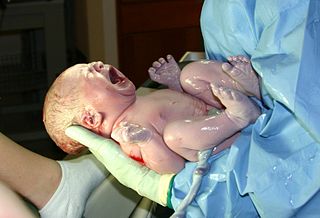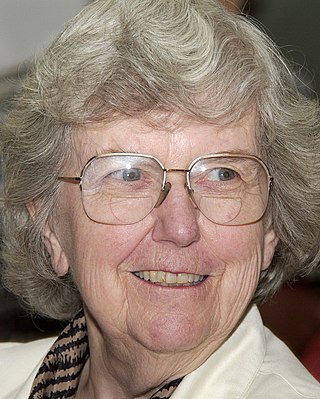Related Research Articles

The Apgar score is a quick way for health professionals to evaluate the health of all newborns at 1 and 5 minutes after birth and in response to resuscitation. It was originally developed in 1952 by an anesthesiologist at Columbia University, Virginia Apgar, to address the need for a standardized way to evaluate infants shortly after birth.

Neonatology is a subspecialty of pediatrics that consists of the medical care of newborn infants, especially the ill or premature newborn. It is a hospital-based specialty and is usually practised in neonatal intensive care units (NICUs). The principal patients of neonatologists are newborn infants who are ill or require special medical care due to prematurity, low birth weight, intrauterine growth restriction, congenital malformations, sepsis, pulmonary hypoplasia, or birth asphyxia.

A neonatal intensive care unit (NICU), also known as an intensive care nursery (ICN), is an intensive care unit (ICU) specializing in the care of ill or premature newborn infants. The NICU is divided into several areas, including a critical care area for babies who require close monitoring and intervention, an intermediate care area for infants who are stable but still require specialized care, and a step down unit where babies who are ready to leave the hospital can receive additional care before being discharged.
In ABO hemolytic disease of the newborn maternal IgG antibodies with specificity for the ABO blood group system pass through the placenta to the fetal circulation where they can cause hemolysis of fetal red blood cells which can lead to fetal anemia and HDN. In contrast to Rh disease, about half of the cases of ABO HDN occur in a firstborn baby and ABO HDN does not become more severe after further pregnancies.

Newborn transport is used to move premature and other sick infants from one hospital to another, such as a medical facility that has a neonatal intensive care unit and other services. Neonatal transport services such as NETS use mobile intensive care incubators fitted with mechanical ventilators, infusion pumps and physiological monitors capable of being used in a mobile environment. These transport systems seek to emulate the environment of a neonatal intensive care and permit uninterrupted care to occur in a referring hospital and then during the journey by road or air ambulance. Power and medical gas supplies are carried within the system as well as making use of external supplies; as available. Infant transport systems commonly weigh over 100 kg and present a challenge to vehicle operators in terms of weight, manual handling, crashworthiness and power consumption.

Montreal Children's Hospital is a children's hospital in Montreal, Quebec, Canada. Founded in 1904, it is affiliated with the McGill University Health Centre (MUHC) and McGill University, Faculty of Medicine.
Clostridial necrotizing enteritis (CNE) is a severe and potentially fatal type of food poisoning caused by a β-toxin of Clostridium perfringens, Type C. It occurs in some developing regions, particularly in New Guinea, where it is known as pig-bel. The disease was also documented in Germany following World War II, where it was called Darmbrand (literally "bowel fire," or bowel necrosis). The toxin is normally inactivated by certain proteolytic enzymes and by normal cooking, but when these protections are impeded by diverse factors, and high protein is consumed, the disease can emerge.

Mary Ellen Avery, also known as Mel, was an American pediatrician. In the 1950s, Avery's pioneering research efforts helped lead to the discovery of the main cause of respiratory distress syndrome (RDS) in premature babies: her identification of surfactant led to the development of replacement therapy for premature infants and has been credited with saving over 830,000 lives. Her childhood, mentors, drive, and education inspired Avery to be the visionary that she was. In 1991 President George H.W. Bush conferred the National Medal of Science on Avery for her work on RDS.

Morgan Stanley Children's Hospital of NewYork-Presbyterian is a women's and children's hospital at 3959 Broadway, near West 165th Street, in the Washington Heights neighborhood of Manhattan, New York City. It is a part of NewYork-Presbyterian Hospital and the Columbia University Irving Medical Center. The hospital treats patients aged 0–21 from New York City and around the world. The hospital features a dedicated regional ACS designated pediatric Level 1 Trauma Center and is named after financial firm Morgan Stanley, which largely funded its construction through philanthropy.

Rainbow Babies & Children's Hospital is a pediatric acute care children's teaching hospital located in Cleveland, Ohio. It is affiliated with Case Western Reserve University School of Medicine and has a neonatal intensive care unit (NICU), pediatric intensive care unit (PICU), and level 1 pediatric trauma center.
Vanderbilt University School of Medicine is a graduate medical school of Vanderbilt University located in Nashville, Tennessee. Located in the Vanderbilt University Medical Center on the southeastern side of the Vanderbilt University campus, the School of Medicine claims several Nobel laureates in the field of medicine. Through the Vanderbilt Health Affiliated Network, VUSM is affiliated with over 60 hospitals and 5,000 clinicians across Tennessee and five neighboring states, managing more than 2 million patient visits each year. It is considered one of the largest academic medical centers in the United States and is the primary resource for specialty and primary care in hundreds of adult and pediatric specialties for patients throughout the Mid-South.
James Geddes Stahlman was an American newspaper publisher and philanthropist. He was the publisher of the Nashville Banner. He was opposed to desegregation.

Monroe Carell Jr. Children's Hospital at Vanderbilt, also known as Children's Hospital at Vanderbilt, is a nationally ranked pediatric acute care children's teaching hospital and entity of Vanderbilt University Medical Center in Nashville, Tennessee. The hospital is affiliated with Vanderbilt University School of Medicine's Department of Pediatrics.
Certified in Neonatal Pediatric Transport (C-NPT) is the designation in the USA for a paramedic, physician, respiratory therapist, neonatal nurse, nurse practitioner, nurse or physician assistant who has earned certification from the National Certification Corporation in neonatal and pediatric transport. This certificate of added qualification was rolled out in 2009. National Certification Corporation utilizes applied measurement professionals to administer its tests.
Neelam Kler is an Indian neonatologist, known for her pioneering work on neonatal intensive care and ventilation. She is credited with developing neonatal care to better the survival rate of extremely tiny preterm babies to 90 per cent. The Government of India honoured her with the third-highest civilian award, Padmabhushan, in 2014, for her services to the fields of medicine and neonatology.
John Colin Partridge is an American pediatrician and neonatologist, and an expert on neonatal intensive care, perinatal brain imaging, international medical education and neonatal medical ethics. He is a Professor Emeritus of Pediatrics at the University of California, San Francisco and held the Academy Chair in Pediatric Education, an endowed chair at the same university, from 2007 to 2013. According to Google Scholar, his work has been cited over 6,700 times in scientific publications, and his h-index is 37.
Roberta A. Ballard is recognized for her contributions to neonatal medicine. In 1965, she graduated from the University of Chicago's medical school and has dedicated much of her life to research on newborn prenatal health. Specifically, Dr. Ballard studies ways to treat and prevent chronic lung disease in premature infants. Some of her research includes the collection of data regarding how inhaled Nitric Oxide can help premature infants who are suffering from lung disease and are undergoing medical ventilation. From her studies she was able to find that Nitric Oxide reduced the risk of death and shortened hospitalization time for infants born prematurely who suffer from lung disease. These contributions have helped to prevent chronic lung disease and brain injury harming infants. Hospitals that Dr. Ballard is associated with include the Hospital of the University of Philadelphia, University of PA Medical Center/Presbyterian, Saint Christopher's Hospital for Children, and Children's Hospital of Philadelphia. Dr. Ballard also served as a Professor of Pediatrics at the University of California, San Francisco School of Medicine. Currently, she is Emeritus Professor of Pediatrics and Obstetrics and Gynecology at the University of Pennsylvania. While also being a professor, Dr. Ballard has contributed her knowledge in articles including the New England Journal of Medicine, Pediatrics, Journal of Perinatology, and more. She has served on a number of scientific and medical boards including the American Board of Pediatrics in 1972 and is an author of the book Avery's Diseases of Newborns. The book focuses on the care and treatment of neonates. Dr. Ballard's research and contributions have helped enhance technology and prevent infant death. Her improvements in technology have not only improved the lives of premature infants, but she also seeks to help women who are pregnant to assure they receive proper prenatal attention.

Children's Hospital at Erlanger is a 118-bed, tertiary care children's hospital located in Chattanooga, Tennessee. The hospital serves as the pediatric center of excellence for Erlanger Health System, the tenth largest public health system in the United States. Children's Hospital at Erlanger treats infants, children, teens, and young adults aged 0-21. It is located adjacent to Erlanger Baroness Hospital, just east of downtown Chattanooga.

Oklahoma Children's Hospital at OU Health is a nationally ranked, freestanding acute care women's and children's hospital in Oklahoma City, Oklahoma. It is affiliated with the University of Oklahoma College of Medicine. The hospital features all private rooms that consist of 246 pediatric beds. The hospital provides comprehensive pediatric specialties and subspecialties to infants, children, teens, and young adults aged 0–21 throughout the region. The hospital also sometimes treats adults that require pediatric care. The hospital has a rooftop helipad and is an ACS verified level 1 pediatric trauma center, the only one in Oklahoma. The hospital features a regional pediatric intensive-care unit and an American Academy of Pediatrics verified level IV neonatal intensive care unit.
Daniel Cody Darrow was an American pediatrician and clinical biochemist whose research focused on fluid and electrolyte balance in the human body. He pioneered the routine use of intravenous potassium in patients after surgery, and in children with diarrhea.
References
- 1 2 "Mildred Stahlman, M.D." National Institutes of Health. Retrieved 2009-06-10.
- ↑ Stahlman, M.T. (1984). "Newborn intensive care: Success or failure?". The Journal of Pediatrics. 105 (1): 162–167. doi:10.1016/S0022-3476(84)80386-8. PMID 6737135.
- ↑ Stahlman MT (Mar 1979). "Ethical dilemmas in perinatal medicine". Journal of Pediatrics. 94 (3): 516–520. doi:10.1016/s0022-3476(79)80640-x. PMID 423058.
- ↑ VUMC Reporter: Birthday wishes
- ↑ Claverie, MC. "Life-saving neonatal caregiver Mildred T. Stahlman, M.D '40 celebrates her 100th birthday". harpethhall.org . Retrieved August 2, 2022.